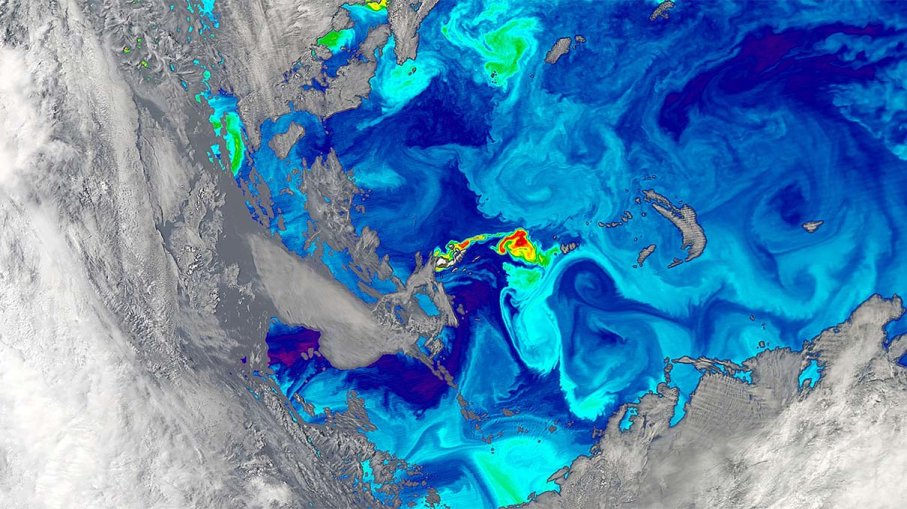Why Is the Ocean Different Colors in Different Places?

Someone gazing out at the ocean from the Maine coast sees very different hues than someone squinting at the sea from a sunny beach on a Greek island. So why does the ocean come in so many shades of blue?
First of all, as NASA oceanographer Gene Carl Feldman points out, “The water of the ocean is not blue, it’s clear. The color of the ocean surface for the most part is based on depth, what’s in it and what’s below it.”
A glass of water will, of course, appear clear as visible light passes through it with little to no obstruction. But if a body of water is deep enough that light isn’t reflected off the bottom, it appears blue. Basic physics explains why: Light from the sun is made up of a spectrum of different wavelengths. The longer wavelengths appear to our eyes as the reds and oranges, while the shorter ones appear blue and green. When the sun’s light strikes the ocean, it interacts with water molecules and can be absorbed or scattered. If nothing is in the water except water molecules, light of shorter wavelengths is more likely to hit something and scatter, making the ocean appear blue. The longer, red portions of sunlight, meanwhile, are absorbed near the surface.
Depth and the ocean bottom also influence whether the surface appears a dusky dark blue, as in parts of the Atlantic, or casts a sapphire-like shimmer as in tropical locations. “In Greece, the water is this beautiful turquoise color because the bottom is either white sand or white rocks,” Feldman explains. “What happens is the light comes down and blue light gets down, hits the bottom and then reflects back up so you make this beautiful light blue color in the water.”
Color Reflects Ocean Health
And then there’s the fact that the ocean is rarely clear, but is instead teeming with tiny plant and animal life or filled with suspended sediment or contaminants. Oceanographers monitor the ocean’s color as doctors read the vital signs of their patients. Color seen on the ocean’s surface reflect what’s going on in its vast depths.
Feldman, who’s based at the NASA Goddard Space Flight Center in Maryland, studies images taken by the Sea-viewing Wide Field-of-view Sensor (SeaWiFS) satellite, launched in 1997. From its perch, more than 400 miles (644 kilometers) above Earth, the satellite captures Van Gogh-like swirls of the ocean’s colors. The patterns are not only mesmerizing, but they also reflect where sediment and runoff may make water appear a dull brown color and where microscopic plants, called phytoplankton, collect in nutrient-rich waters, often tinting it green.
Phytoplankton use chlorophyll to capture energy from the sun to convert water and carbon dioxide into the organic compounds. Through this process, called photosynthesis, phytoplankton generate about half of the oxygen we breathe. While most phytoplankton give ocean water a green tint, some lend it a yellow, reddish or brown tint, Feldman says.
Oceans with high concentrations of phytoplankton can appear blue-green to green, depending on the density. Greenish water may not sound appealing, but as Feldman says, “If it weren’t for phytoplankton we wouldn’t be here.” Phytoplankton serve as the base of the food web and primary source of food for zooplankton, which are tiny animals eaten by fish. The fish are then eaten by bigger animals like whales and sharks.
It’s when oceans become polluted with runoff that the amount of phytoplankton can escalate to unhealthy levels. Phytoplankton feed on the pollutants, flourish and die, sinking to the bottom to decompose in a process that depletes oxygen from the water.
The Climate Change Effect
Over the past 50 years, ocean zones with depleted oxygen have more than quadrupled to an area roughly the size of the European Union, or 1,728,099 square miles (4,475,755 square kilometers), according to a study published in January 2018 in the journal Science. Part of the cause may be an increase in ocean temperature due to climate change since warmer water supports less oxygen. In coastal areas, phytoplankton blooms are suspected to be the cause. Phytoplankton may serve as the base of the ocean food chain, but as Feldman says, “Too much of a good thing is not a good thing.”
On a map on Feldman’s office wall is a marker showing where there is little human interference and ocean water is perhaps the clearest on the planet. In this region, off the coast of Easter Islandin the southeast Pacific Ocean, the water is deep and remarkably clear due to its location in the middle of a giant oceanic gyre, or large circular current. Its central location means there is minimal mixing of ocean layers and nutrients aren’t pushed up from the deep bottom. The purity of the water here, coupled with its depth make the ocean here appear a deeper indigo than perhaps anywhere else.
“The light just keeps going down, down, down; there’s nothing that bounces it back,” Feldman says, “Here is the deepest blue you’ll ever see.”
